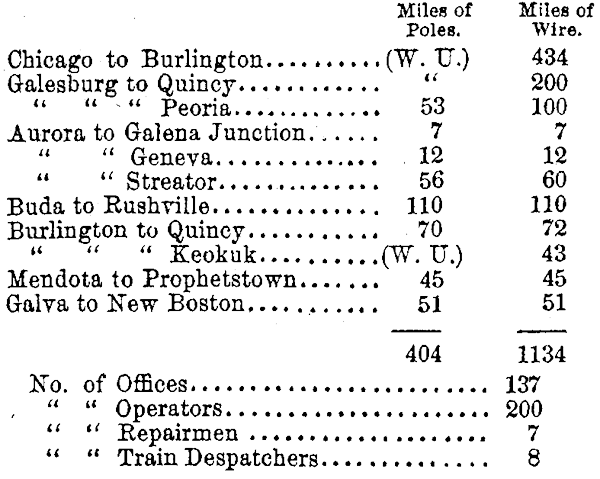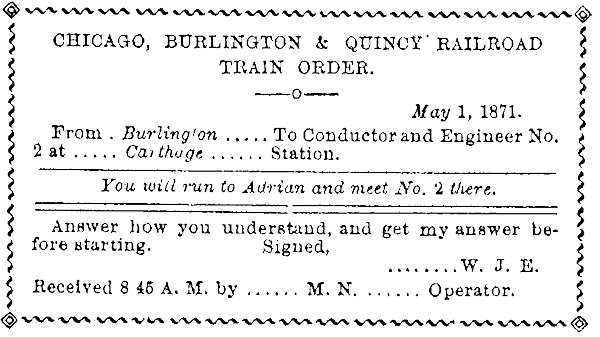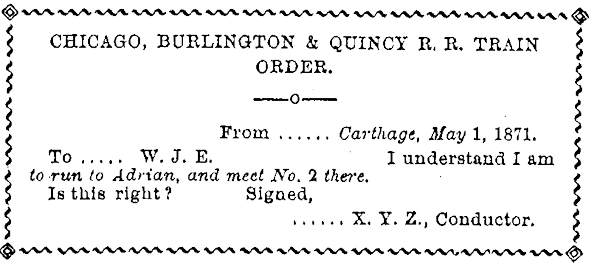[Trade Journal]
Publication: The Telegrapher
New York, NY, United States
vol. 7, no. 41, p. 321-322, col. 1-3
Original Article.
The Chicago, Burlington and Quincy Railroad
Telegraph.
THE Chicago, Burlington and Quincy has always been justly considered one of the model railroads of the West. The great care and efficiency of its management, and the attention which is paid to even the minutest details of its construction and operation, cannot fail to instantly attract the attention of the observant traveller [sic] traveler who has occasion to pass over any portion of its main route or of its almost innumerable branches. From the well known enterprise and liberality of this company, in testing and adopting all the latest improvements tending to enhance the comfort, safety or convenience of its passengers and employees, it is but natural to expect that we should find a well equipped, well managed, and efficient telegraph department, forming an important and indispensable adjunct to the proper supervision of the movement of trains and of the general business of the road.
The main line of the road extends from Chicago to Burlington, a distance of 207 miles, but the numerous cross roads and branches belonging to the company swell the aggregate length of track to 756 miles. The line of poles on the main road from Chicago to Burlington and Keokuk, and also from Galesburg to Quincy, originally belonged to the Illinois and Mississippi Telegraph Company, but now form a portion of the Western Union system. One wire over each of the above routes is owned by the Western Union and used for commercial business. The remainder of the poles and wires on the road and its branches belong to the railroad company. The receipts from commercial business are divided in a certain agreed proportion between the railroad and telegraph company, as is usually the case throughout the West.
The total extent of the telegraphic system of the C. B. Q. Railroad will be seen from the following statement:
 |
The Superintendent of Telegraph is Mr. Fred. H. Tubbs, whose headquarters are at Galesburg, Ill. He is assisted by two Division Operators, Mr. W. D. Sargent, who is stationed at Aurora, and has charge of the wires between Chicago and Mendota, and Mr. W. J. Edgar, at Burlington, whose division extends from Burlington to Quincy and Keokuk. The remaining and central portion of the system is under the immediate charge of the Superintendent.
It needs but a slight inspection of the telegraph lines and offices of this company to see that they are under/the charge of a practical electrician, who understands his business, and who attends to it. The same thoroughness and attention to details that characterizes every department of this great railroad is equally apparent here. Eight years ago, when Mr. Tubbs took charge of these lines, the best attainable mode of insulation was such as to render it impossible to get a good working line in wet weather, except by the use of a large conducting wire. He therefore put up a No. 7 wire, regardless of the ridicule and opposition which he met with from the telegraphic officials of that day, who, as is often the case now, went considerably out of their way to oppose a meritorious improvement on a line with which they had nothing to do. The large wire proved a success, of course, and its use was continued until, at the present time, about 700 miles of No. 7 wire have been put up on the principal routes of this company, with the most satisfactory results.
The poles used are of white cedar, from the northern part of Wisconsin, 25 feet in length, except at crossings and other special points, where longer ones are necessary. These cost about a dollar each, delivered on board the cars at Chicago. They are set five feet in the ground, and usually 30 to the mile. The common glass insulator, on wooden pins and brackets, has been used until within two or three years, since which Mr. Tubbs has adopted the Brooks insulator with the usual satisfactory results. He now has about 240 miles of wire on this insulator, and intends replacing all his glass insulators with it in the course of time, as the lines are gradually repaired and rebuilt. The conditions on this line were unusually favorable to the satisfactory performance of the glass insulator, on account of the large conductor employed, and the favorable climate, but the motto of this company is to " Get the best," which they have accordingly done in insulation as in all other matters.
The greater portion of the instruments used on the line are Tillotson's main line box sounders. The employment of these instruments saves much expense and annoyance incident to the use of local batteries, but could hardly have been carried out successfully on wires less carefully constructed and maintained. As it is, they work as well as could be wished for.
All the minor points about the lines, which are too often neglected in many instances, are here looked after with religious fidelity. Every connection on the lines and in the offices is carefully soldered. The office wires are of No. 12 copper, and run with great care, and the leading in wires at the offices scientifically arranged and sheltered from rain and moisture. In the planning and execution of the engineering details Mr. Tubbs has been ably seconded by Mr. E. P. Warner, who has immediate charge of the construction and repairs, and whose work is a sufficient endorsement of his intelligence and ability.
One of the finest specimens of telegraphic engineering in the West is the crossing at the Burlington Bridge, on the Mississippi, on the C. B. and Q. line. It is necessary to carry the wires over the draw at a height sufficient to clear the tallest steamboat chimnies [sic] chimneys at high water. This has been accomplished by erecting three pyramidical towers or frameworks-one on the centre of the draw, and one on the stationary portion of the bridge, each side of the opening. Each tower supports three cross arms carrying two wires each, the arms on the central tower being arranged upon a spindle, by means of collars, so that when the draw is swung round at right angles, to admit the passage of a steamer, and the central tower moves with it, the cross-arms maintain their original position at right angles to the wires and the line of the bridge. The wires at this point are ninety feet above high water mark. This crossing was constructed in 1868, and several similar ones are about to be established at other points along the river.
The system of moving trains by telegraph on this road is an excellent one, and merits a passing notice, though in many respects it differs but little from that employed on other roads. The movements of trains are controlled by the train despatcher - one despatcher being on duty at all times on each division of the road. He has full power to run any engine or train by telegraph that he thinks proper, and no wild or extra train is allowed to run on the road without his knowledge or instructions, unless following a regular train to the nearest station where they can obtain telegraphic orders. Each train is designated on the time schedule and elsewhere by a particular number. The orders from the despatcher are received by the operator, and written down upon a form as follows:
 |
This is shown by the operator to the conductor of train No. 2, who writes his understanding of it upon another blank, in the following form, which is telegraphed back to the despatcher:
 |
If the understanding is correct the despatcher gives the operator O. K., who endorses it upon the original order and delivers it to the conductor, who then, and not before, proceeds to carry it into effect.
If it becomes necessary to hold a train at some station to await the arrival of another one, the despatcher sends an order to that effect to the operator at that station. Each station is provided with a green and a white signal, in full sight of the engineer when approaching from either direction, and also of the operator as he sits at his instrument, and these signals are controlled by a simple mechanical device within reach of the operator's hand. When he receives orders from the despatcher to hold a train he sets the green signal, and then replies that the train is held. If, on coming into a station, the engineer discovers a green signal he comes to a full stop, until orders are received from the despatcher to move forward.
Under this system it is evident that no collision or interference can possibly occur, except through an error of the despatcher, or the grossest violation of distinct and easily remembered orders. By placing the movement of trains under the complete and absolute control of one man the chances of accident are reduced to the lowest minimum. The position of the despatcher, however, is one of great trust and responsibility. It is generally filled by appointment from among the better class of operators, who have distinguished themselves by fidelity and accuracy in the discharge of their duties in that capacity.
It will be seen, from what has been said above, that the telegraph department of the C. B. & Q. Railroad does not suffer in comparison with any of its other departments. The managers of the railroad are evidently fully alive to the fact that the telegraph is the right arm of the service, and having been fortunate in securing a competent and energetic Superintendent and able corps of assistants, do not rest there, but gladly afford them the means and facilities to make the telegraphic department as complete and perfect as possible. We congratulate them on the result. It would be hard to find a better working or better managed system in the United States than the one under consideration; it reflects the highest degree of credit upon all concerned. It is, also, not out of place to observe that a more intelligent, courteous and gentlemanly set of operators than those employed on Mr. Tubb's wires are very seldom met with. Every man seems to feel a just pride in having helped to earn and to maintain the well deserved reputation of the line; and this is, no doubt, one of the principal causes which have led to such a satisfactory result.
F. L. P.
